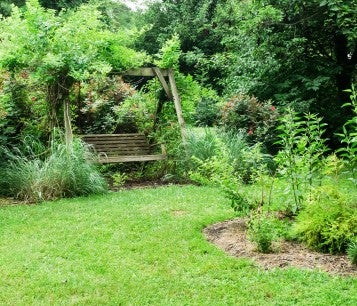The distant view from Kelly Brenner’s Seattle living room was enviable, a testament to the engineering marvels of modern human habitat. But much closer to home were sights even more spectacular than the Space Needle rising hundreds of feet in front of the Olympic Mountains.
Against the backdrop of one of America’s prettiest cities, ladybugs quietly made their way into the world, growing from eggs to adulthood in the small space just outside the sliding door. Hummingbirds sipped from potted lavender and bees, butterflies and hoverflies feasted on native flowers such as sea thrift, nodding onion and red-flowering currant.
“I got so well-acquainted with every little plant and every little nook and cranny that I got to experience really intimately the life cycle,” says Brenner, the blogger behind Metropolitan Field Guide. She even grew some plants from seed on her sixth-story apartment balcony. “It was very rewarding watching the seed grow and become a flower, and then the bee came to see it.”
What was magical to Brenner was life-sustaining to the species who ate and bred in the mini-habitat. Creatures such as caterpillars, crows and scrub jays took advantage of the gourmet feast offered by native plants and herbs, the watering hole made from a shallow container filled with rocks for perching and the shelter provided by clumping plants. The space even included a spice-rack-turned-insect-hotel filled with natural materials like twigs and seedpods.
As the number of Americans living in urban areas has grown—an estimated eight out of every 10—so has the need to make room for our fellow species. According to the global 2005 Millennium Ecosystem Assessment, we’re already degrading or using unsustainably 60 % of the planet’s ecosystem services that benefit humans. That’s not good news for wildlife either, as fragmentation and contamination of habitat diminishes biodiversity and threatens further extinctions.
Fortunately, the opportunities to make a difference are limitless, whether you have a patio, balcony, or like urban farmer Annie Novak, rooftops. Novak’s experiences are a testament to the power of adding plants to all levels of the concrete jungle: She’s spotted the same migrating bird species in vastly different gardens, from a site rising more than 30 stories above the city to the ground-level New York Botanical Garden where she works.
Connecting these green archipelagos into contiguous habitat supports overwintering animals as well. People often emphasize the importance of such efforts in rainforests and other distant places, says Novak, but nature needs our help in downtown New York too. “We live in an ecosystem that has lots and lots of wildlife.”
While conventional small-space gardening advice is easy to find, making a mini-habitat requires a slightly different approach. Here’s how to channel other species’ perspectives when creating pocket gardens for wildlife.
A humane backyard is a natural habitat offering wildlife plenty of food, water and cover, plus a safe place to live free from pesticides, chemicals, free-roaming pets, inhumane practices and other threats. And it's so easy to build!

Gain a sense of place
Research the fauna and wildlife-friendly flora in your community, recommends Novak, by observing animals and their plant preferences at parks and gardens. Learn what’s grown naturally in your region in the past. If you see small gardens that attract animals, including insects, find out the names of the plants and consider adding more. Creating strength in numbers enhances habitat corridors and draws pollinators, who are attracted to mass plantings.
“It’s about a narrative,” says Novak. “It’s not like you hang up a Christmas tree and it’s Christmas. It’s not a cookie-cutter kind of project. You really have to think about who you want to attract, when are they in your area, what do they like to eat.”
Plant natural food for wildlife
If squirrels, pigeons and other generalist species proliferate in your neighborhood, be prepared to welcome them. “I try and emphasize that connectedness of the space,” says Novak, “because otherwise people get let down if they put up a hummingbird feeder and … get squirrels—because squirrels like sugar water, too.”
Just because the habitat is man-made doesn’t mean the food has to be. Instead of hanging feeders, plant native species that provide berries, seeds, pollen, nectar and foliage for wildlife. Include spring-, summer- and fall-flowering plants that offer a succession of blooms; several species with red trumpet-shaped flowers can sustain hummingbirds throughout the season. Make the most of your space with multipurpose plants; Novak likes sunflowers, which feed pollinators while in bloom and birds after going to seed.

What would nature do?
Urban environments can swing more quickly among extremes of heat, drought and flash flooding. Look to the natural world for clues about what will thrive. “While you’re thinking about wildlife, you’re also thinking about what the plant can handle and finding the right plants for the right spot so you can do as little maintenance as possible,” says Anna Fialkoff, a horticulturist at the New England Wild Flower Society.
If your balcony is exposed to sun and high winds, choose plants that grow on ridgetops or on the coast, she suggests. Consider moisture needs, and avoid planting drought-tolerant plants with ones that like to keep their feet wet. Use contrasting microclimates as opportunities to experiment. Situated between two pillars, Brenner’s balcony provided both sun and shade, enabling her to shift plants around.
Give them shelter
Animals visiting your freshly planted balcony or patio bring along with them evolutionary behaviors developed over many millennia. A mama bird who claims a hanging pot for her nest may preclude you from watering your plant for a while, but you’ll gain far more in return: a close-up view of nature at work and a chance to help your wild friends. Watch carefully for such comings-and-goings so you don’t inadvertently remove, flood or otherwise destroy little lives in the making.
Add vines, bushes, small trees and grasses that offer cover and nesting areas, planting straight species rather than cultivars when possible. While some cultivars bred for compactness can be useful, some may have lost nutritional value for wildlife in the process, Fialkoff notes.
Be adaptable
Small adjustments to existing structures can accommodate the needs of both human and wild neighbors. Brenner laughs at the memory of seeing aphid honeydew—a sticky but unobtrusive substance that likely went unnoticed by anyone else—on the railing below her. She recalls sleepless nights worrying that her terra-cotta pots, even as heavy as they were, would blow off the balcony. But she took care to prevent dousing the people downstairs with water, covering the metal slats of her balcony floor with wood decking atop an outdoor rug.
In spite of its challenges, Brenner still misses her mini-habitat even after relocating to a single-family home. Small spaces have benefits (“almost no weeding!” she says) and their own kind of magic—a chance to connect with nature in places that, in many cases, previously had none. Through her continued outreach, she hopes to engage more city dwellers in the biodiversity right outside their doors.
Maybe they’ll even be inspired to help. “If everybody had at least two or three containers of plants, that could be [...] equivalent to a meadow for pollinators,” Brenner says. “If all the buildings through the whole city did that, you couldn’t even imagine.”
Want more content like this?
This was written and produced by the team behind All Animals, our award-winning magazine. Each issue is packed with inspiring stories about how we are changing the world for animals together.
Learn MoreSubscribe
